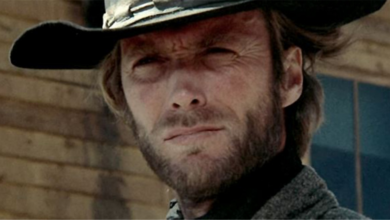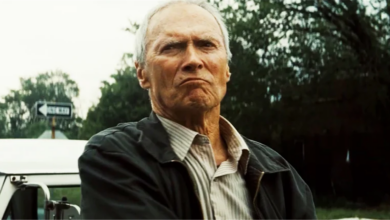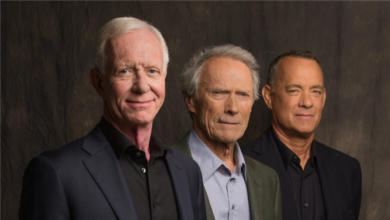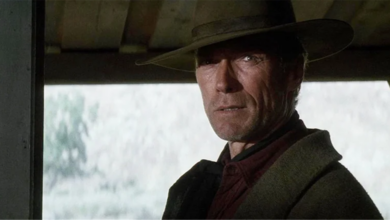Two Mules for Sister Sara: Clint Eastwood co-stars with Shirley MacLaine in Don Siegel’s amusing blend of Spaghetti Western and romantic-comedy
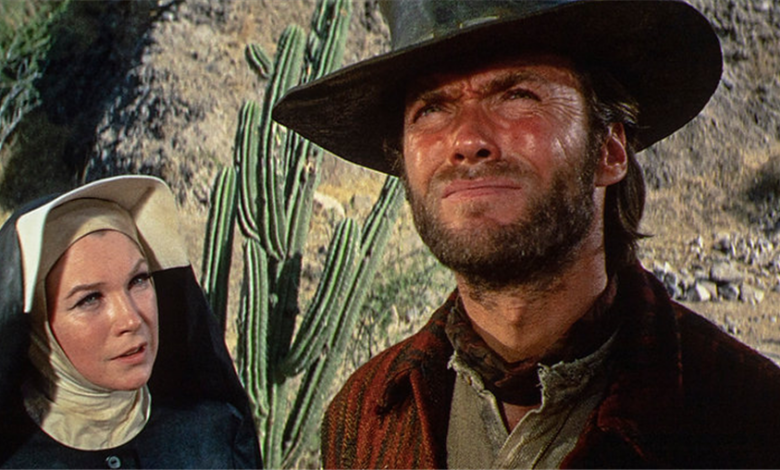
Two Mules of sister Sara(1970) is a quirky Western directed by Don Siegel, and starring Shirley MacLaine and Clint Eastwood in lead roles. The film mixes the aesthetics of a Sergio Leone Western with the romantic-comedy elements from John Huston’s African-Adventure, The African Queen, to arrive at a highly enjoyable romantic-comic Western adventure.
The quirky Ennio Morricone soundtrack, the earthy Mexican locales, and an unshaven Clint Eastwood wearing the same gun and holster (not to mention a Vest designed to look like those iconic ponchos) he wore in “Man with no Name” films; Two Mules for Sister Sara(1970) could very easily be mistaken for a Sergio Leone spaghetti Western or a Leone-knockoff cooked up by some American Leone-wannabe. Suffice to say that the film is neither. The film is directed by one of the great American action-directors of all time, Don Siegel, who has a unique directorial voice of his own- which is very different from Leone’s. One thing he had in common with Leone was that he was a mentor and regular collaborator for Clint- when the latter was starting out as an American mainstream movie star. This was Siegel’s second film with Clint- they had done the cop-drama Coogan’s Bluff(1968) before; and rather surprisingly, he chose to tackle a film that was more in Leone’s ballpark, but as the film proceeds, we realize that except for the surface similarities, this is very different from the Westerns that Leone made with Clint. For starters, Clint maybe playing an American mercenary in Mexico – à la the anti-hero of “A Fistful of Dollars”- here, has a proper name, “Hogan”, and he gets to speak lot more lines of dialogue than in a Leone Western. Secondly, one of the coolest and sexiest aspects of “Man with no Name” was the absence of regular American hero characteristics like a personal moral code- instead he has a cool, nonchalant personal style- and romantic relationships with women, here, he definitely has the latter- with Shirley MacLaine’s Madonna\whore hybrid, Sara. As for the “code”, he develops one as the film progresses, though Siegel does not disappoint his fans by completely eschewing the iconic Clint Eastwood “Personal style”. One could say that the this film (and Clint’s character) is an Americanized and contemporized (for the late 60s) version of Leone’s “Dollar” movies. What if Eli Wallach’s “Tuco” in The Good, the Bad and the Ugly was a woman?. How will Clint’s character relate to her, and what changes would that character make in Clint; that’s pretty much the scenario of “Two Mules for Sister Sara”. That way, this film, fully financed, produced and released by an American studio, can be considered a bridge between Clint’s Leone Westerns and his latter day American Westerns, most of which he himself would direct. This film, beautifully photographed in eye-popping technicolor- all vibrant reds and oranges- by the great Mexican cameraman Gabriel Figueroa, is basically a two-character story echoing John Huston’s “The African Queen” and “Heaven Knows Mr. Allison.”
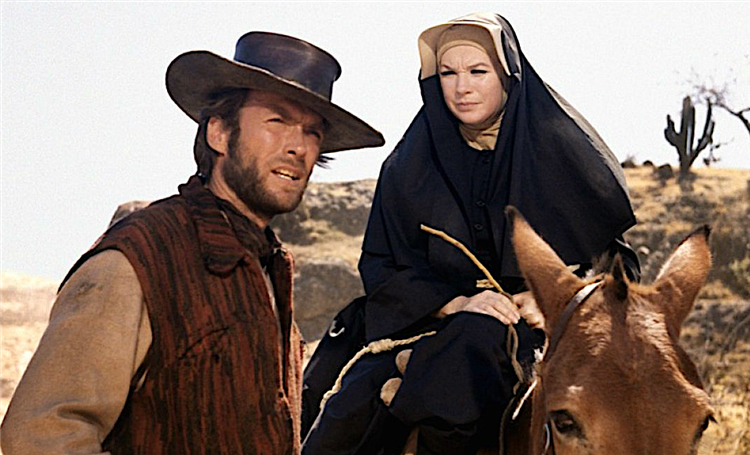
And just like Clint’s introduction sequence in “The Good, the Bad and the Ugly”- where he’s seen saving Tuco from three bounty hunters, here too, the opening finds Clint saving a semi-naked Sara from three bandits who are trying to rape her. Clint guns down two of them, and when the third uses Sara as a shield, he coolly drops a lit grenade at his side; and then when he tries to run, Clint comes out of his hiding place and shoots him in the back and kills him. Then he nonchalantly walks down, pick up the grenade and diffuses it before it blows. Yup! just your cool and stylish “Man with no name”, right?. But unlike the “Dollars” films, Clint doesn’t turn and ride away after the killing is done; when he comes to know that Sara is a nun, he decides to escort her to safety before proceeding on his more mercenary pursuits. Just to give some context to the above events: the year is 1865, just after the civil war, Hogan, an American mercenary arrives in Mexico looking to make some quick money. Mexico, at this time, is engulfed in its own civil war; with the intervention of Napoleon III of France, Archduque Maximilian was installed as emperor in Mexico, but Mexican countrymen banded together under exiled president, Benito Juarez (known as Juaristas) and started fighting to rid the country of Frenchmen and their puppets. Sister Sara, presumably a nun, has adopted Juaristas’ cause and is being pursued by the French army for raising money for them. It is at this point in the story where the film opens, and we see her being attacked by bandits and Hogan saving her. As it so happens, Hogan himself is on his way to meet the revolutionaries-he has made a deal with them to attack the French garrison in Chihuahua on Bastille Day, in exchange for half the garrison’s treasury- and he agrees to take Sara to the Juaristas camp.
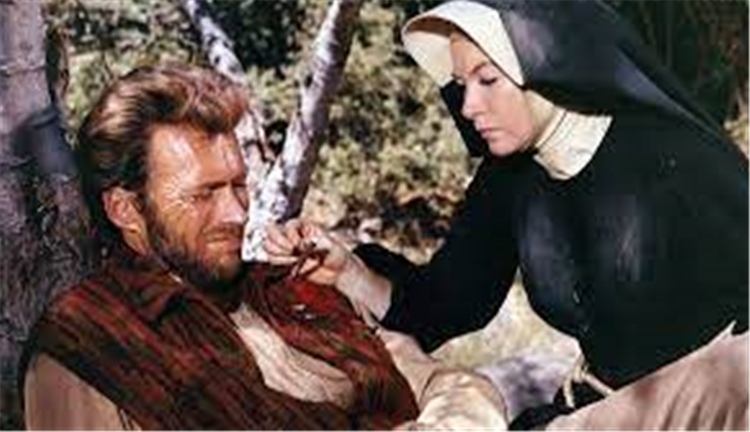
Soon, the French soldiers are after them, and though Hogan sets up a clever diversion, they cannot shake of the soldiers. Finally, they find safe haven in a ruined fort. At night, when Hogan is asleep, we find that Sara is smoking the left over of Hogan’s cigars and drinking whiskey on the sly- obviously, there’s more to this nun than we know (that’s if the sexy Shirley MacLaine with her prominent fake eyelashes hasn’t already given it away). As they continue on their journey, they get into further adventures; Sara’s mule becomes lame, and when it appears that Hogan has to leave her behind, a miracle happens, when she manages to trade her lame mule for a burro from a peasant. At a Mexican village, they get information that they’re to first destroy a French ammunition train. But on their way, they are attacked by Yaqui Indians, who seriously wound Hogan by shooting an arrow into his shoulder. Sister Sara uses the reflection off her cross to drive the superstitious Indians away. Hogan gets totally drunk to tolerate the pain while Sara digs around the shaft of the arrow and carves a groove in it so he can put gunpowder on it, fire it up, and push it out the back of his shoulder. The ‘operation’ completed successfully, they move on to blow up the train. Only problem is that Hogan is so drunk and delirious that he can neither climb the trestle to plant the dynamite on the pylons nor can he shoot at the charges to explode them. With great trepidation, Sara manages to climb the trestle and plant the dynamite. Come time to blow it up, Hogan can barely hold the gun, leave alone fire it accurately. The train is on its way, and Hogan keeps missing every shot, until Sara cusses and punches him down. Hogan recovers in the nick of time and manages to nail one stick of dynamite, and the entire structure collapses under the train. Hogan’s suspicions’ about the nun are now heightened- he had already caught her drinking whiskey – and he demands to know whether she has been cussing; Sarah transfers the blame on to his drinking, which is making him imagine things.
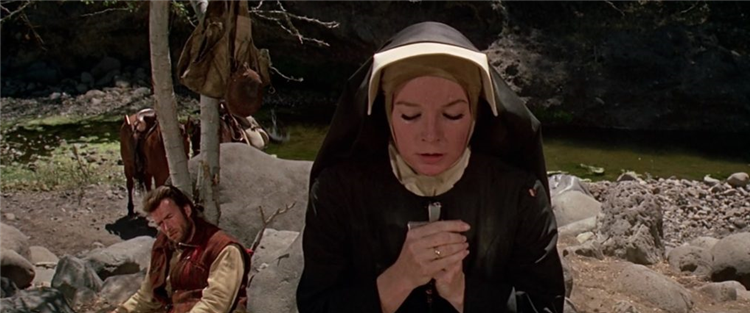
Finally, the reach the Juaristas camp, which is commanded by Col. Beltran (Manolo Fábregas). There, Hogan gets to see with his own eyes the plight of the poor peasants living in caves in the mountains. Since blowing up the French fort will require more dynamite, Hogan leaves for Texas to purchase them. Sara is waiting for him when he returns, and both of them, along with Beltran & his men, move towards the fort. They observe the g arrison from the top of a church adjacent to the fort, and they’re surprised to find that the the soldiers are on full alert; since it’s Bastille day they had expected them to be drunk, but the attack on the train had forewarned them of an impending attack. Now Sara takes them to another secret passage to get into the fort that is hidden under a whorehouse. The prostitutes there wholeheartedly welcomes Sara, and it dawns on a dumbfounded Hogan that Sara is doing a different kind of god’s work. Anyway, the two team up to devise a plan to storm the fort: a squad of revolutionaries will pass through the underground trapdoor, while two other squads attack the gates and a fourth act as snipers. Hogan and Sara infiltrate the fortress by Hogan posing as a bounty hunter who has captured Sara and is turning her in for the reward. The ruse works, Hogan and Sara engage the French commanding officers while the garrison’s gates are breached for the Mexican revolutionary forces to swarm through. The battle won, Hogan gets his half of the treasury as promised, and he and Sara once again embark on an adventurous journey, this time as man and wife.

MacLaine, being the quintessential New York stage actress, who worked based on the character’s motivations and such, clashed repeatedly with Siegel and Clint, who were the old-Hollywood pros, whose motto was “just do it”. MacLaine questioned every direction that Siegel gave her, and walked off the set if she did not get satisfactory answers, incurring the wrath of even an even-keeled Clint. But it did not affect their on-screen chemistry, even though i believe that the film would have been served better having an extroverted Elizabeth Taylor in the role; Taylor would have worked much better with Clint and Siegel. She is not as great an actress as MacLaine, so she may not have brought the layers that MacLaine brings to this role, but she definitely has the old-fashioned star wattage to match up to Clint, which MacLaine lacks. Also, both Clint and MacLaine being introverts and internalized actors, their chemistry never catches fire beyond a point. Clint needs someone to bring him out of his shell- like Meryl Streep does in “Bridges of Madison County”, and MacLaine, is much too self-absorbed to do that. Their scenes do not sparkle the way the scenes between Bogart and Hepburn does in “The African Queen”. Though individually, both of them give good performances, especially Clint, who I think is very good. In fact, I think it’s his best performance up to this point in his career. He had become extremely confident in his ability and it shows, he is more chatty than your usual ‘Eastwood cowboy’, and he exchanges some witty dialogue with MacLaine. And much of the humor in the film flows from all the comical frustration that Clint delivers, having to behave himself in the company of an attractive nun.

The scene where a drunk Hogan confesses his amorous feelings for the nun, when she’s trying to take the arrow out of his shoulder is Clint at his most funny and talky; the same with the latter scene at the train trestle, though here, it’s MacLaine who scores more than Clint in the comedy department: it’s tense and funny at the same time, with Clint’s Hogan unusually relaxed and confident from the drinking, and MacLaine as Sara having to juggle a lot of emotions in this particular sequence; the pressure of keeping up her masquerade; tackling the dangers involved in the moment; emphasizing the importance of the train destruction and her increasing tension in getting a useless Hogan to turn useful again as the train gets closer and closer. But despite the light hearted nature of the movie, Hogan is as deadly as any Eastwood cowboy- he is incredibly cool and macho in every frame of the movie and quite deadly with every kind of firearm. It’s one of the reasons why Boetticher hated this film; his conception of the lead character was more romantic and vulnerable and not the ‘Spaghetti cool’ Hogan that Clint plays in the film. Boetticher was also angry about the fact that “Sara not being a Nun” was revealed far too early in the film- in his original script, it’s revealed only in the film’s final scene. But one still feels Boetticher’s fingerprints on the film, particularly in the way a lean and clean Western narrative is build up in the backdrop of a harsh landscape using very limited number of characters with little exposition on their backgrounds. Siegel’s widescreen compositions are exquisitely beautiful and he keeps the action scrappy and pulpy. Siegel, who’s not much of a comedy director, does rather well with the scenes between Clint and MacLaine, but he’s better at shooting the action\adventure bits, especially the blowing up of the bridge and the climax sequence, which shows an incredible amount of blood & gore that’s not in keeping with the tone of the rest of the film.
But the most striking aspect of the film is a truly eccentric and inventive score by maestro Ennio Morricone. The film may not match up to any of Leone’s Westerns, but the score is every bit as good (if not better) than his scores for Leone. Orchestra, organ, guitar and choir meld in strikingly original fashion, expertly heightening, enriching and propelling the film’s varied tones. The film’s main theme that mixes nun’s choir singing- “… and lead us not into temptation.”- with electronic Mule brays is one of the most brilliant instances of using music to convey the story; the music- shifting from the divine to comic- perfectly reflecting a duplicitous Sara impersonating a nun and riding a mule. In fact, the whole title sequence- with that Morricone music throbbing on the soundtrack- that has Hogan riding his horse, and dragging a pack mule, across an arid Mexican landscape, burnished by a golden sun, and filled with scenes from nature and its animals is absolutely wonderful. Morricone also composes a marching theme very similar to the “Ecstasy of gold” theme from “The Good, The Bad and The Ugly”; here it appears in the scene where Hogan, Sara and the revolutionaries are climbing the steps of the church adjacent tot he fort. The musical themes from this film was used by Quentin Tarantino in his Western, “Django Unchained.” By the way, Shirley MacLaine gets top billing in the film’s credits- though Clint was billed above MacLaine in overseas territories keeping with the fact that he was the bigger star there. This was the last time Clint Eastwood received second billing (or anything less than first) until “A Perfect World” starring Kevin Costner, and the only time his leading lady was played by an A-list star until “The Bridges of Madison County”.

